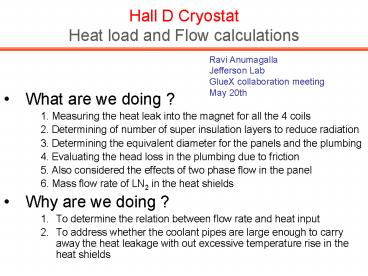Hall D Cryostat Heat load and Flow calculations - PowerPoint PPT Presentation
1 / 12
Title:
Hall D Cryostat Heat load and Flow calculations
Description:
2. Determining of number of super insulation layers to reduce radiation ... Calculations are based on homogenous model. The governing equations are ... – PowerPoint PPT presentation
Number of Views:27
Avg rating:3.0/5.0
Title: Hall D Cryostat Heat load and Flow calculations
1
Hall D Cryostat Heat load and Flow calculations
Ravi Anumagalla Jefferson Lab GlueX collaboration
meeting May 20th
- What are we doing ?
- 1. Measuring the heat leak into the magnet for
all the 4 coils - 2. Determining of number of super insulation
layers to reduce radiation - 3. Determining the equivalent diameter for the
panels and the plumbing - 4. Evaluating the head loss in the plumbing due
to friction - 5. Also considered the effects of two phase flow
in the panel - 6. Mass flow rate of LN2 in the heat shields
- Why are we doing ?
- To determine the relation between flow rate and
heat input - To address whether the coolant pipes are large
enough to carry away the heat leakage with out
excessive temperature rise in the heat shields
2
Support Link
Vacuum Tank Cover
114 Dia
Helium Vessel
Inner Panel
Outer Panel
Intermediate Panel
Cake Pan
Support Side Panels
Cross section of coil 2,3,4
All Dimension Are In Inches
77.5 Dia
73 Dia
3
Convection ? Is reduced by evacuating the coil to
10 -5 torr The total heat load on each coils are
as follows
4
Hall D thermo-siphon
5
Determination of equivalent Diameter
- Verification of Equivalent diameter
- Methods
- Analytical calculations
- CAD geometry verification
- Experimental calculations
- Governing Equations for Analytical Calculations
- These Equations have been derived from Darcy
Weibachs equation and Blasius Equations
Where Dl Equivalent diameter for N number of
passages ds Equivalent diameter for a single
passage N number of passages f friction
factor in a single passage
6
Equivalent Diameter
Section A-A
Section A-A
7
(No Transcript)
8
Experimental setup at ODU
9
Results
10
Flow Calculations
- Calculations are based on homogenous model
- The governing equations are
DPtot Total pressure drop (gm/cm2) DPcorr Two
phase pressure drop correction factor DPmix
Pressure drop in two-phase flow piping
(Panels/Returns) (gm/cm2) DPliq Pressure drop
in single phase supply line (gm/cm2) DPgrav
Differential density induced driving pressure
(gm/cm2)
11
COIL 4
COIL 2 / COIL 3
94
227
Mass Flow Rate VS Heat Load
The cooling is generally considered to adequate
if the thermo-siphon flow rate increases under an
increased heat load, the safe design load to
choose would generally be 6 times or more
12
Void Fraction VS Heat Load































